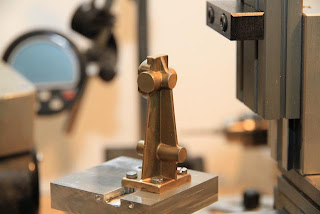I recently bought a Taig lathe (a.k.a.the Peatol lathe in the UK - I'm not entirely sure why) with a view to doing a spot of clock making, making some steam engines and tools for violin making.
I decided to start on a set of castings for a Stuart Turner Oscillator steam engine, since it's relatively cheap and I won't be wasting too much metal if I screw it all up.
First up, I decided to tackle the main casting. The port face seemed to be pretty much at right angles to the base, so I held it against one of the jaws of the chuck and approached with caution.
A few passes and I get a reasonably clean finish, considering the rather suspect way I'm holding the casting...
...and then a few runs over an Arkansas stone and it came up beautifully smooth.
I checked the base against the port face and it looks promising, so next up is the port face itself.
I sat the casting on a piece of 12mm aluminium sitting on the bed, and held the casting where it sat in the 4-jaw chuck, checking continually that the base was still actually sitting on the alu block. When i removed the block, i was guaranteed enough space for the casting to rotate, albeit with a fair amount of vibration. Gentle passes with the cutter seemed to do the trick.
A few rubs on the oilstone and the faces come up beautifully smooth.
Spent a fair while satisfying myself that the port face and the base were at right angles. A pleasant evening's work.
Next up, I decided to turn the crankshaft. I had a hell of a time getting a smooth finish from the cutter on mild steel - it just kept tearing out. However, I read a hint in Peter Wright's Model Engineering - A Foundation Course suggesting that a flat face on the cutter would help, and it certainly did!
Now I've turned the shaft, i need to turn the crank disk. Fortunately, Peatol sent me a headstock for collets which works beautifully for this sort of thing (with a set of collets from RDG Tools).
I parted it off, then finished up the surface.
Reasonably happy with the result.
Back to the casting. I used the alu block to clamp the port face of the casting, more or less ensuring that the base is parallel to the chuck. I used a square on the bed of the lathe to ensure the casting was at right angles vertically.
Next I bolted the casting to the alu block and held it in a milling attachment (I don't yet have a mill, but my initial experience with the steam engine kit suggests I would have been better off getting the mill before the lathe).
A few gentle passes and I'm done. Same on the other side.
With the port face and the steam inlets/outlets milled, that gave me enough right angles to mill the other faces, once I'd milled a slot to the correct depth in the alu block.
Next up, marking the holes in the port face using an elegant and economical universal bevel protractor from RDG tools.
I don't have a height gauge yet, so I just clamped a needle in the milling attachment to bring a line from the port face to the steam inlet/outlet faces. It's just amazing how many tools you need.
I clamped a try square to the milling attachment to get a square line across the top
Plucked up the courage to drill holes. I should have drilled pilot holes, but I think I got away with it. Time will tell.
Drilling the hole for the driveshaft. I ran the drill too fast, and the metal just got harder and harder....
...but I got there in the end. Forgot to take pics of the flywheel, but it was a straightforward operation. I decided to extend the wheel so I can attach a drivebelt.
I have two headstocks (the headstock for collets is different), so I used one to help me align the casting so I can cut some space for the spring. There must be an easier way to do this!
I held the casting in a 3-jaw chuck with a screw, and approached with caution.
After a few alarming minutes, the turning was done. After some false starts I realised I had to mill away a bit of the casting before I could turn safely.
Testing the fit of the spring. Very satisfying.
Next I needed to plug the holes I'd made in the top. It took me a while to realise why these holes were further apart than the holes on the port face, but of course there needs to be space for the pivot stud, so the vertical holes need to overlap with the port face holes just enough to let the steam through.
I milled some brass bar 0.1mm wider than the holes, with a little bevel on the end to make it easier to fit, then squeezed it in with a vice. It took a fair bit of effort and I was worried that the casting would crack, but I got away with it....
...twice :-) I figure that the steam pressure will push the cylinder off the port face before the plugs pop out.
Filed the plugs down....
...then milled....
...then polished on an Arkansas stone, as usual.
No sign of the plugs at all! It does suggest, however, that the casting is brass, not gunmetal! Of course, there's no reason for it to be quite as polished or refined as this since it's probably going to be painted, but it's extremely satisfying.
Now I'm stuck until my BA taps and dies arrive in the post....































No comments:
Post a Comment